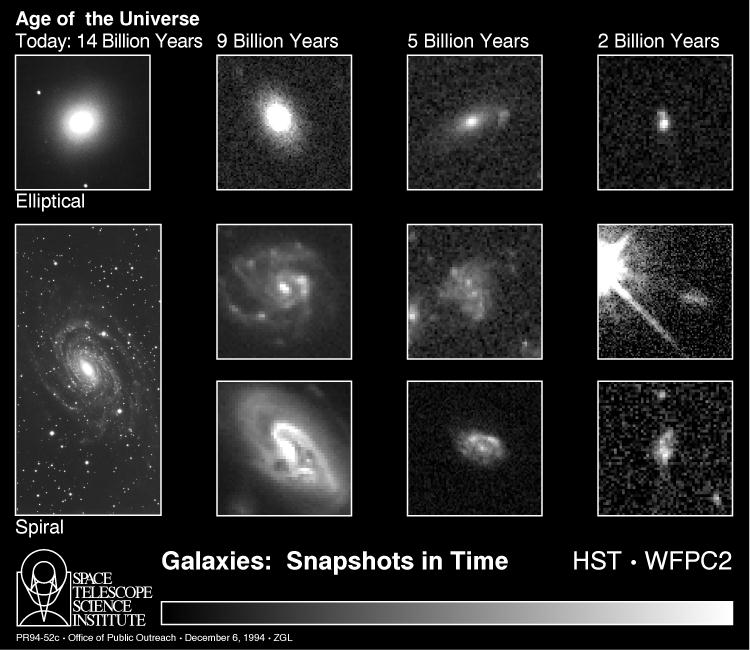
How Did Structure Form in the Universe?
Astronomers observe considerable structure in the universe, from stars to galaxies to clusters and superclusters of galaxies. The famous "Deep Field Image" taken by the Hubble Space Telescope, shown below, provides a stunning view of such structure. How did these structures form? The Big Bang theory is widely considered to be a successful theory of cosmology, but the theory is incomplete. It does not account for the needed fluctuations to produce the structure we see. Most cosmologists believe that the galaxies that we observe today grew from the gravitational pull of small fluctuations in the nearly-uniform density of the early universe. These fluctuations leave an imprint in the cosmic microwave background radiation in the form of temperature fluctuations from point to point across the sky. The WMAP satellite measures these small fluctuations in the temperature of the cosmic microwave background radiation, which in turn reveals the early stages of structure formation.
Hubble Deep Field Image:

HST press release describing this image
In its simplest form, the Big Bang theory assumes that matter and radiation are uniformly distributed throughout the universe and that general relativity is universally valid. While this can account for the existence of the cosmic microwave background radiation and explain the origin of the light elements, it does not explain the existence of galaxies and large-scale structure. The solution of the structure problem must be built into the framework of the Big Bang theory.
Gravitational Formation of Structure
Most cosmologists believe that the galaxies that we observe today grew gravitationally out of small fluctuations in the density of the universe through the following sequence of events:
- When the universe was one thousandth its present size (roughly 500,000 years after the Big Bang), the density of matter in the region of space that now contains the Milky Way, our home galaxy, was perhaps 0.5% higher than in adjacent regions. Because its density was higher, this region of space expanded more slowly than surrounding regions.
- As a result of this slower expansion, its relative over-density grew. When the universe was one hundredth its present size (roughly 15 million years after the Big Bang), our region of space was probably 5% denser than the surrounding regions.
- This gradual growth continued as the universe expanded. When the universe was one fifth its present size (roughly 1.2 billion years after the Big Bang), our region of space was probably twice as dense as neighboring regions. Cosmologists speculate that the inner portions of our Galaxy (and similar galaxies) were assembled at this time. The stars in the outer regions of our Galaxy were probably assembled in the more recent past. Some cosmologists suspect that some of the objects recently detected by the Hubble Space Telescope may be galaxies in formation.
HST Images of Galaxies in Formation?

HST press release describing this image
Observing These Small Fluctuations
Tiny variations in the density of matter in the early universe leave an imprint in the cosmic microwave background radiation in the form of temperature fluctuations from point to point across the sky. These temperature fluctuations are minute: one part of the sky might have a temperature of 2.7251 Kelvin (degrees above absolute zero), while another part might have a temperature of 2.7249 Kelvin. NASA's Cosmic Background Explorer (COBE) satellite, has detected these tiny fluctuations on large angular scales. WMAP re-measures the fluctuations with both higher angular resolution and sensitivity. The mission summary page offers a quick introduction to how WMAP achieves this sensitivity - more details are available on the technical information page.
What Made These Small Fluctuations?
While gravity can enhance the tiny fluctuations seen in the early universe, it can not produce these fluctuations. Cosmologists speculate about the new physics needed to produce the primordial fluctuations that formed galaxies. Two popular ideas are:
- Inflation
- Topological Defects
These different theories make very different predictions about the properties of the cosmic microwave background fluctuations. For example, the inflationary theory predicts that the largest temperature fluctuations should have an angular scale of one degree, while the defect models predict a smaller characteristic scale. WMAP, with its superb sensitivity, indicates that the inflationary model is more likely.
Learn More About Structure Formation at These Sites:
The Sloan Digital Sky Survey (SDSS)
This group plans to map the positions of over 100 million galaxies and determine the
distances to over a million galaxies and quasars. The effort will produce the largest
(known) survey to date of cosmic structure in the universe. You can learn more about the
details of the SDSS by visiting their home page at Fermilab.
The Virgo Consortium
The Virgo Consortium is an international grouping of scientists carrying out super
computer simulations of the formation of galaxies, galaxy clusters, large-scale structure,
and of the evolution of the intergalactic medium. Although most of the consortium members
are British, there are important nodes in Canada, the United States, and Germany.
The University of Washington N-Body Shop
This group creates software simulations for studying large-scale structure formation and
planet formation, and host an interesting image gallery.
The Hubble Space Telescope
HST has been able to observe distant galaxies and study the formation and evolution of
galaxies. A well known image depicting this is a
Hubble Deep Field image released on January 15th, 1996.
